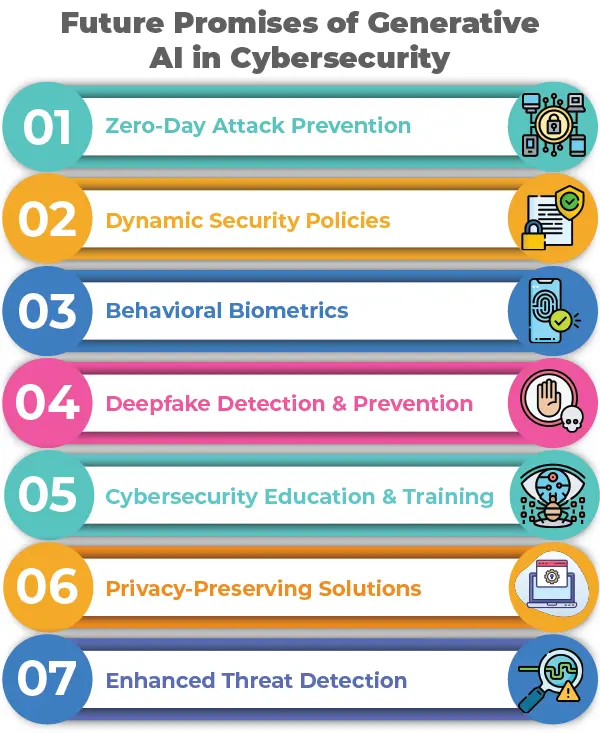You see an interesting picture or video while browsing your preferred social media feed. It appears almost too realistic, yet it has an eerie quality. Is it the handiwork of an ingenious digital artist or a gifted artist?
We welcome you to explore the inspiring world of generative AI, where computers are not just processing data or obeying commands but producing unique material that blurs the lines between reality and imagination. This transformative technology expands machines’ capabilities, creating lifelike images and videos, crafting narratives, and even composing music.
Amidst the remarkable advancements of generative AI, a pressing concern emerges about its potential impact on cybersecurity. As we marvel at the capabilities of these AI systems, we must also recognize the threats they pose to our digital defenses. How can we protect our cybersecurity from potential adversarial usage while harnessing the power of generative AI? This question demands our immediate attention and vigilance.
Prepare for an exhilarating journey into the intricate relationship between cybersecurity and generative AI. In this era of artificial intelligence, as we navigate the ever-evolving landscape of digital security, we’ll uncover the opportunities, risks, and promises that lie ahead. So, get ready because cybersecurity is on the brink of a thrilling transformation, and you’re about to be part of it.
What is Generative AI?
In simple words, generative AI (GenAI) is a type of artificial intelligence that enables users to generate unique and relevant content based on various provided inputs. By completely transforming the domain of content creation, GenAI speeds up the production of textual, animated, and visual material. Examples of Generative AI platforms include chatbots and virtual assistants, 3D modeling, music generation, image creation, game development, video generation, code generation, and many others.
How Generative AI Works?
Generative AI, or generative adversarial networks (GANs), operates on advanced principles inspired by game theory. For your better understanding, we have divided its working as follows:
1. Framework
Generative AI comprises two neural networks: the generator and the discriminator. Both of these are trained competitively simultaneously.
2. Generator
This network creates new data instances similar to the provided training data. For example, if trained on dog images, it will generate new and diversified dog images according to user demand.
3. Discriminator
This network differentiates between real data instances like real dog images and fake ones generated by the generator.
4. Training Process
During the training process, the generator produces indistinguishable data from real data, while the discriminator tries to improve its ability to differentiate real from fake.
5. Competition
As training is pursued, both networks improvise their operations. The generator gets better at producing realistic data, whereas the discriminator gets better at identifying fake data.
6. Equilibrium
This process reaches equilibrium when the generator produces indistinguishable data from real data, and the discriminator can’t reliably detect the difference.
7. Applications
Generative AI has applications in different fields, including text-to-image synthesis, image generation, music generation, and many more. It is used for tasks like producing artwork, designing molecules in drug discovery, coding, generating realistic images, and many more.
Role of Generative AI in Cybersecurity
Generative AI plays a crucial role in cybersecurity, providing offensive and defensive capabilities as shown below:
1. Threat Detection and Analysis
Generative AI simulates different attack scenarios, supporting the cybersecurity team in anticipating potential vulnerabilities and threats in their systems. It generates synthetic data to train detection systems, allowing them to identify new and evolving threats more efficiently.
2. Adversarial Training
Generative adversarial training (GANs) generates examples crafted to fool machine learning models used in cybersecurity defenses. By producing such examples, security teams train their systems to become robust against adversarial attacks.
3. Anomaly Detection
Generative AI techniques help identify anomalies in network traffic, user behavior, or system logs by learning normal patterns and flagging deviations from them. They can be instrumental in detecting insider threats, potential security breaches, and unusual system behavior.
4. Malware Detection and Analysis
Malware Detection and Analysis: Generative models can help generate synthetic malware samples, aiding in developing and testing malware detection algorithms. They can also analyze malware behavior and identify patterns that may indicate malicious intent.
5. Privacy Preservation
On the defensive side, generative models generate synthetic data for privacy-preserving analysis without exposing sensitive information. This is useful when sharing real data for analysis, which may pose privacy risks.
6. Security Testing and Evaluation
Generative AI can automate the process of generating diverse attack vectors for penetration testing, assisting organizations in identifying weaknesses in their systems before malicious actors exploit them. It also aids in evaluating the effectiveness of security measures and protocols.
7. Automated Response
In specific cases, generative AI can automatically respond to cyber threats by developing countermeasures and deploying security patches. This automatic response can help minimize the time utilized to mitigate security incidents.
8. Cybersecurity Education and Training
Generative AI can simulate realistic cyber attack scenarios for training cybersecurity professionals. This hands-on training helps develop practical skills for effectively responding to and mitigating cyber threats.
Future Promises of Generative AI in Cybersecurity
1. Zero-Day Attack Prevention
Generative AI plays a significant role in proactively identifying and mitigating zero-day vulnerabilities. By simulating potential attack vectors and analyzing system behavior, generative models help organizations proactively patch vulnerabilities before attackers can exploit them.
2. Dynamic Security Policies
Generative AI will enable the development of dynamic security policies that can adjust to changing conditions and threats. Through ongoing data analysis and insight generation, security policies will become increasingly flexible and responsive, providing the best possible defense against new threats.
3. Behavioral Biometrics
Generative AI will make creating sophisticated behavioral biometric systems for anomaly detection and user authentication easier. Cybersecurity systems can differentiate between malicious actors and legitimate users by creating user behavior models based on their interactions with digital systems.
4. Deepfake Detection and Prevention
GenAI will be crucial in identifying and halting the spread of fraudulent text, video, and audio content as deep fake technology develops. Cybersecurity systems can recognize and warn of possible deepfakes by creating models of real media and comparing them with stuff that seems suspect.
5. Cybersecurity Education and Training
Generative AI will remain a vital component of cybersecurity education and training. For cybersecurity experts, generative models will simulate actual cyber attack scenarios and offer hands-on learning experiences to help them acquire practical skills for defending against developing threats.
6. Privacy-Preserving Solutions
GenAI will be used to create cybersecurity solutions that protect privacy in light of the growing concerns over data privacy. Organizations can do threat assessments without jeopardizing the protection of sensitive data by creating synthetic data for analysis and training.
7. Enhanced Threat Detection
The capacity of Gen AI to model and forecast novel cyber threats will continue to develop. With generative AI models, cybersecurity systems can keep ahead of developing threats and weaknesses. These models analyze massive quantities of data and generate realistic attack scenarios.
Solutions for Overcoming Challenges in Implementing Generative AI for Cybersecurity
1. Enterprise Transformation
Data security and privacy are major problems with the increasing use of chatbots and LLMs, especially in the corporate world. We predict a move toward training private large language models (PLLMs) using proprietary datasets and a greater focus on workforce education on safe GenAI use. To reduce the risk of data leaking, corporations may also implement policies that restrict the usage of AI products.
2. Neural Networks in Visual Scam
Scammers are ready to use neural networks to create more authentic-looking fake content, increasing the potency of their tricks. AI-generated images and landing pages have the potential to make scams more common, which highlights the value of cyberliteracy and strong antivirus protection in thwarting fraudulent activity.
3. Security-by-Design
Deploying new GenAI models in cybersecurity systems introduces new risks like model extraction attacks and model inversion attacks, where attackers exploit vulnerabilities in the model to gain access to sensitive information or proprietary algorithms. Initially, security should be considered while designing and implementing generative AI systems. Ensure that generative AI models are resilient to adversarial assaults; this entails carrying out comprehensive security evaluations, putting in place strong access controls, and keeping an eye out for odd activity.
4. Privacy-Preserving Techniques
Gen AI models mostly require large amounts of data to train effectively, raising privacy concerns, especially when sensitive data is involved. Generative AI models can be trained using privacy-preserving methods, including secure multi-party computation, federated learning, and differential privacy, all without jeopardizing the privacy of sensitive data. These methods allow models to learn from dispersed data sources without exchanging raw data, alleviating privacy concerns without compromising model performance.
5. Interpretability Methods
Cybersecurity experts may find it difficult to comprehend how generative AI models arrive at their conclusions because they are frequently intricate and tricky to interpret. Scientists are working on ways to understand the choices made by Gen AI algorithms. Techniques like feature attribution, attention mechanisms, and model distillation can facilitate better decision-making in cybersecurity tasks. These techniques can offer insights into how the model creates outputs and improves transparency and trustworthiness.
6. Fairness-Aware Training and Bias Mitigation
Intentional bias perpetuated in training data by generative AI models can result in unfair or discriminating conclusions incorporated into the training pipeline. To guarantee fair results and reduce the possibility of unintentional biases, you can go for preprocessing data, regularizing the model, and adjusting post-processing fairness.
Sum Up
Generative AI has enormous potential to revolutionize cybersecurity by providing cutting-edge methods for identifying and reducing online threats. By tackling adversarial attacks, data privacy, and bias mitigation, we can use generative AI to protect against new cyber threats and strengthen our digital defenses.






